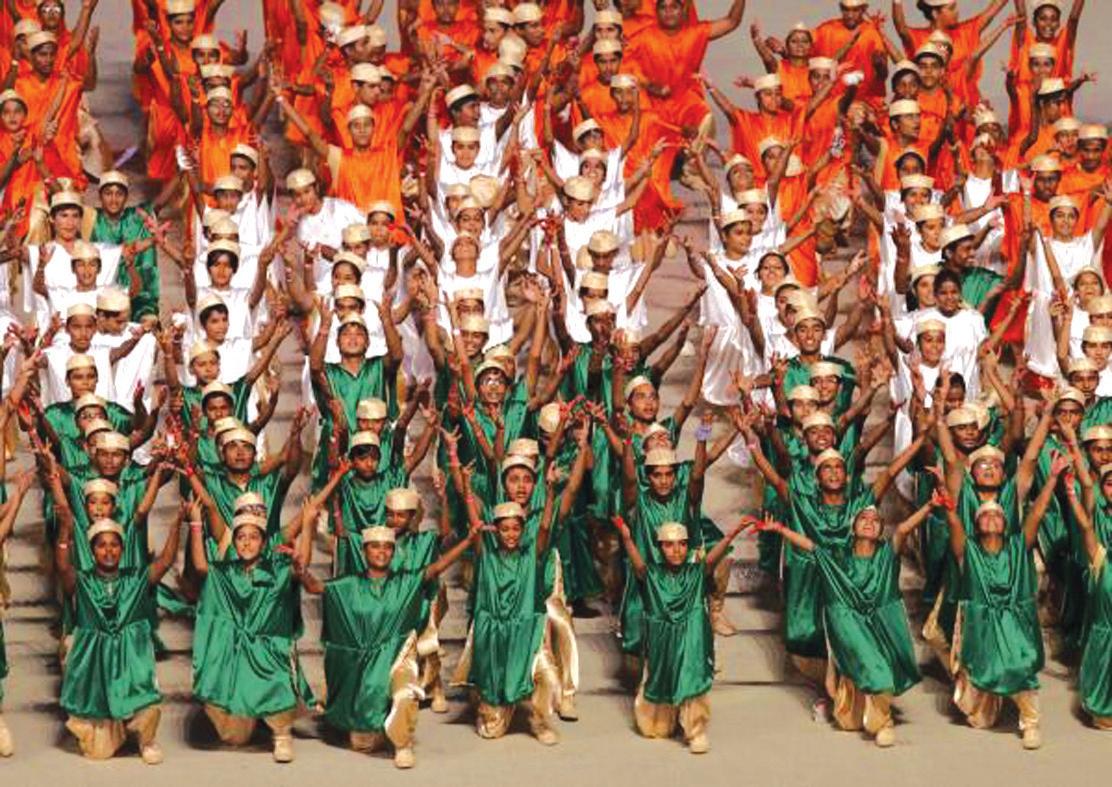
2 minute read
performance
from 2010-10 Melbourne
by Indian Link
as it dramatically rose 25 metres in the air when the ceremony began, to the awe and delight of the crowd which showed its appreciation through a roar of approval. It is the biggest in the world, and displayed images of the action on the ground for all to see across the dimensions of the stadium, while moving lights changed hues to add an individual touch of festivity to the ceremony.

Brilliantly choreographed, ‘The Great Indian Journey’ was certainly entertaining and definitely impressive. From the train and its dancer perched on top, to the medley of scenes that followed like milkmen on bicycles, a mobile bangle shop, a cycle shop, rickshawallas, fishermen…it was a glimpse into the ‘real’ India. The wedding band and moving theatre with huge cutouts of Bollywood actors added a touch of realism to the scene without overtly venerating the industry, which I feel, made an essential statement that India is much more than mere Bollywood.
The section on the Bodhi tree of life and knowledge and yoga showcased what is essentially Indian, leaving no doubt about the origins of this form of wellness, which is still enjoying steadily-increasing global popularity. The
Namaste formation by schoolchildren was attractive, and the traditional dances were graceful and vibrant, with bihu, bhangra and bamboo all displayed to their best advantage. And of course, the piece de resistance was from AR Rahman, who did his bit with his usual aplomb. Rahman’s talent lies in being a showman extraordinaire without the usual fuss – he’s just good at what he does, with humility to boot. He belted out the Commonwealth Games theme song, Jiyo Utho Badho Jeeto (Live, rise, grow, win) to an impressed audience, and followed it up with what is now his signature tune, Jai Ho! The accompaniment of hundreds of dancers in traditional Indian attire perfectly complemented his performance.
With a tribute to Father of the Nation Mahatma Gandhi, there was a distinct message that Bapuji’s ideals are still very much alive and that he remains, 62 years after his death, India’s single strongest and most prideful icon. Strains of the Mahatma’s favourite hymn Vaishnav Janato reverberated through the air as his ever-familiar portrait lit up the stage.
Of course, there were a few glitches, but nothing terribly obvious. The speeches seemed too long and too many, an insight into our politicians’ love for verbosity. And although the Games Organising Committee chairman Suresh Kalmadi had to endure being booed by the audience, I have to admit that his valour in calling a spade a spade left me impressed. He referred to the criticism prior to the Games and his statement, “India has arrived!” made global headlines. The President and Prime Minister of India were less impressive, and seemed mildly out of their depth with all the excitement around them.
Purists may criticise the faint air of disorganisation that seemed to hover around the ceremony and the occasionally uncoordinated moments experienced by dancers when caught close up on camera, but these are minor deterrents to a kaleidoscopic pageant that literally, took one’s breath away.
Three hours isn’t quite enough for 7000 performers to showcase the 5000 years of India’s history to nearly 7000 athletes and Games organisers from 71 countries, and an audience of 65,000 in the stadium including countless others watching all across the world. But one has to admit, they did a more than impressive job of it!


So let’s wait for the closing ceremony, where we hope that once again, India can show the world that it has the ability, attitude, creativity and panache to bring the 19th Commonwealth Games to a successful conclusion. And once again, perhaps at 3:30am, I will crawl back into bed with a sense of satisfaction and a sigh of relief.









